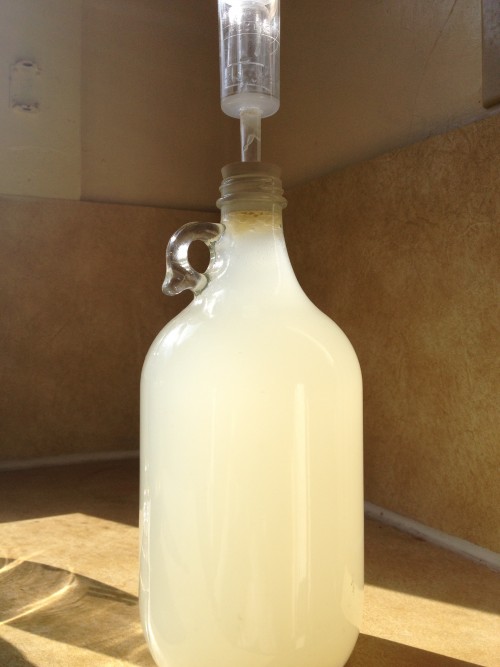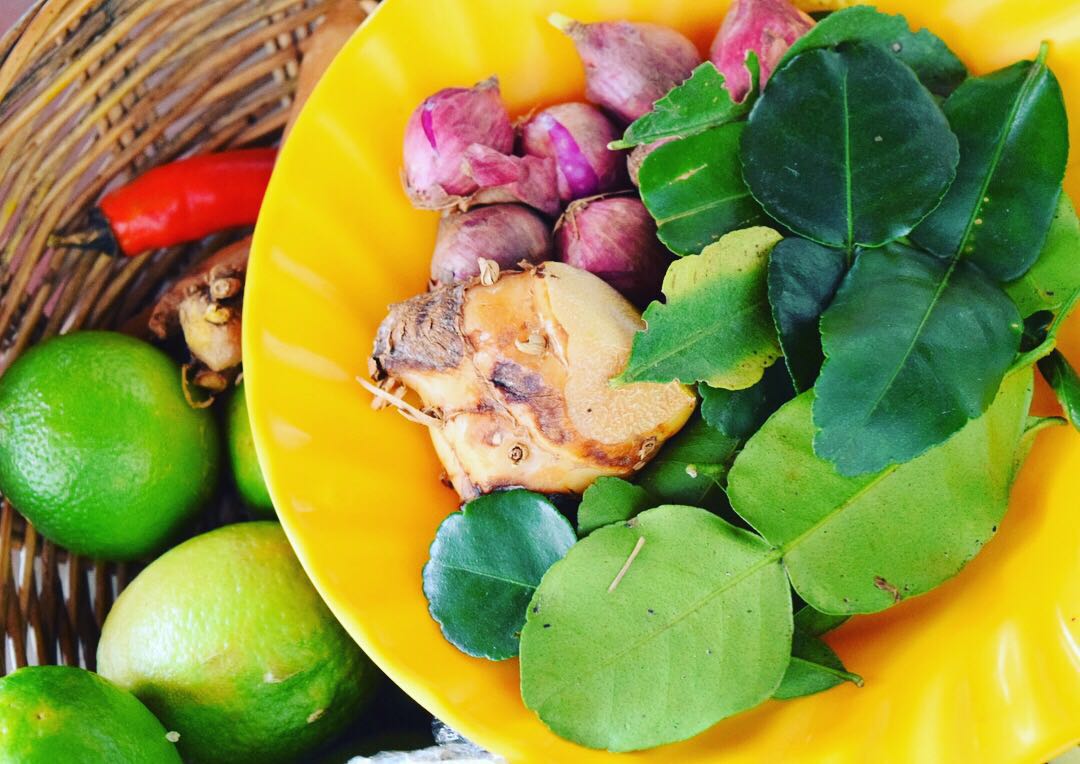Next time someone tells me home-brewing is easy, I won’t believe them. Home-brewing is hard. Really hard. I sort of want to gouge my eyes out at how hard it is. In theory, it seems like a breeze. Mix ginger, lemon juice, sugar and water, add a dash of yeast. Shake it all up, and in a week, you’ll be sipping sparking ginger beer on your porch, with a good book and a nice summer breeze at your back. Lies. It’s not like that at all.
The process starts with boiling water. I was warned that to stop bacterial growth, I would need to pasteurize the living hell out of everything that would touch the ginger beer (“including myself”, I asked?). So sanitize I did. I submerged my glass growler in boiling water and thought that would be it. It wasn’t. Next came the little contraption I just learned a few moments ago is called a fermentation lock.

The fermentation lock hangs out at the top, sealing the solution and also letting gas bubbles escape without letting air back in. Without a fermentation lock, too much pressure would build up within the bottle and there is a chance of it exploding (I was told that without this lock, never to use glass bottles, lest they turn to shrapnel all over you). The alternative to using a fermentation lock is to pop the cap of the ginger beer open once every few days to let the trapped air escape, but in that case, you should only use plastic, for fear of aforementioned glass explosion. Even then, it’s slightly unsafe, so if brewing is in your future, invest the $2.50 in a proper fermentation lock, or fear picking out shards of glass from your skin for weeks.
Once the fermentation lock was clean, I needed to clean the measuring cup I would use, the measuring spoon, every other spoon I would touch, then I move on to scrubbing my hands (a futile task, I would soon discover).
Step one of brewing is to make the gingerette — a super concentrated ginger simple syrup. In theory, if you don’t want to ferment the ginger beer, it is possible to add the gingerette to to club soda and stop there. But that would be called ginger ale and not real ginger beer, also I am not a quitter so I didn’t stop there. To make the gingerette, I started with the ginger, using one average-sized root. I peeled the ginger with a spoon (a trick I learned on the internet, that is supposed to produce minimal waste) and grated the ginger into a strainer where I then squeezed out the juice from the roots by hand. To that I added a buttload of sugar and some (non-boiled) water. I boiled the syrup for about five minutes and let it stand for another hour, until it became viscous, like honey. Phase one was complete.
Phase two involves lemon. Again, I poured boiling water on every surface that poor lemon would touch before it’s imminent demise. I juiced it into measuring cup, taking out the seeds but not the pulp (everyone wants texture in their ginger beer, right?). I think that was mistake no. 1. I poured the lemon juice, pulp and all, into my brewing jug. Next came the ginger syrup. The final step to what was supposed to be quite an easy journey was adding the water. Like everything that came before it, the water needs to be boiled. What I did not realize at the moment, was that the water would be needed to be boiled and then cooled down. If the water is too hot, it will kill the yeast, too cold and the yeast will lie dormant instead of getting to work on fermenting the beer. And so I waited. And I waited. And then I added the yeast, closed off the bottle with the fermentation cork and let the beer work its magic.
That’s when I noticed that the lemon pulp I left in there started to work against me. The pulp floated to the top and blocked off the fermentation cork, sealing the exit and leaving me in the kitchen with an IED in the making. I scrambled, opened up the container, desperately trying to clean it before it became dangerous, while keeping everything perfectly sanitary in the process. Ginger beer was everywhere, but the pulp was finally out. And so I let it sit, trying not to think about the botulism.
By day two, there was no movement. When the yeast in ginger beer starts working, bubbles are supposed to come to the surface and the water level is supposed to rise up. None of that was happening with my brew. And so I thought, heat activates yeast, right? I poured hot water into a mixing bowl, and submerged the growler inside it. Instantly the bubbles started forming. They went down just as instantly when the water cooled. The logical thing would have been to find a warmer place for the bottle. That is not what I did. I bathed my ginger beer in warm water for the next three days, holding it close, like an alcohol baby.
By day four, the magic started happening. The water baths must have paid off, because the beer finally started to carbonate.

I still don’t know what it tastes like, and I won’t find out until a few days, but after the pain and headache it has caused me, it better taste great. I’m a little terrified that it’ll end up more like prison hooch rather than ginger beer, but either way I’m proud of myself.
For those brave enough to attempt making ginger beer, here are my ingredient proportions (adapted from Tori Avey):
GINGERETTE INGREDIENTS
1 cup sugar
1/2 cup water
1 medium grated fresh ginger
GINGER BEER INGREDIENTS
1/8 tsp active dry yeast
Gingerette syrup (above)
3 tbsp freshly squeezed lemon juice
7 cups filtered water
While on the topic of homemade (maybe healthy?) drinks, I tried a shot of wheatgrass for the first time yesterday. I was at a farmer’s market in Union Square and there was an entire stand dedicated to selling the green juice (fun fact I just learned is that wheatgrass is a precursor to the Malt in beer, so in a way, I was drinking pre-beer). In an effort to be spontaneous, I bought a shot. For $3 a pop, it couldn’t hurt me, right? The taste of wheatgrass really reminded me of the taste of brie, and well, if you know me, you know what I think brie tastes like. So in a few words, the taste of wheatgrass is… unappealing. It has a very unpleasant Splenda-like aftertaste and although it’s supposed to be packed up the wazoo with proteins, Vitamin E, and the like, next time I’ll stick to the kale smoothies.



I cannot even count the amount of things wrong with this.
All of the mistakes you made is was made this process hard for you. Any research at all on this subject would have made this a much better experiance.
Youtube is your freind here. Once you see it done the right way, you will know I mean.
I hope there is a follow up brew with correct techniques
I’m sorry you didn’t find the post a good read. I don’t claim to run a recipe blog; these are mostly musings about my life with light exaggeration for my ineptitude in the kitchen. I assure you the process went much smoother in real life than in my head 🙂 I did my research, but I couldn’t find that many good resources for brewing ginger beer at home.
I hope you keep reading my blog!